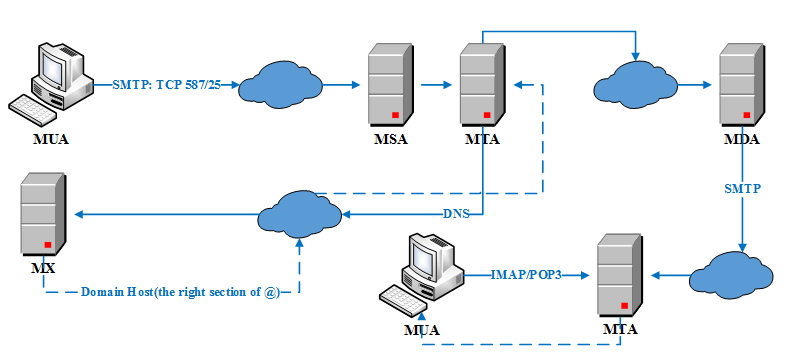邮件发送模型及其Python应用实例
SMTP(Simple Mail Transfer Protocol)
制定:
First:RFC 788 in 1981
Last:RFC 5321 in 2008
端口:
TCP 25(SMTP), TCP 465/587(SMTP_SSL)
功能:
用户客户端:
发送消息:SMTP
接收和管理消息:POP3、IMAP
邮件服务器:
发送和接收消息:SMTP
说明:
SMTP仅定义了消息传输格式(如消息发送者参数),而非消息内容(如消息头和消息体)。
邮件发送模型

流程描述:
(1) 使用SMTP协议,通过MUA(Mail User Agent)提交邮件到MSA(Mail Submission Agent),然后MSA递送邮件到MTA(Mail Transfer Agent)[通常而言,MSA和MTA是同一邮件服务器上的两个不同例程,其也被称为SMTP服务器]。
(2) MTA通过DNS在MX(Mail Exchanger Record)上查询接收者的邮件服务器。
(3) MTA发送邮件到目标邮件服务器MTA,其间可能是两个MTA直接通信,或者经过多个SMTP服务器,最终到达MDA(Mail Delivery Agent)。
(4) MDA直接递送或者通过SMTP协议,将邮件递送到本地MTA。
(5) 终端应用程序通过IMAP/POP3协议接收和管理邮件。
SMTP协议
SMTP由3部分构成:
- MAIL:建立发送者地址。
- RCPT:建立接收者地址。
- DATA:标志邮件内容的开始。邮件内容由两部分构成:邮件头和以空行分割的邮件体。DATA是一组命令,服务器需要做两次回复:第一次回复表明其准备好接收邮件,第二次回复表明其接收/拒绝整个邮件。
一个简单的SMTP发送示例(主要为了说明SMTP的3个部分),如sender给receiver1和receiver2发送邮件:
S:表示SMTP服务器 C:表示SMTP客户端
客户端C建立TCP连接后,服务端S通过greeting建立会话(附带服务器的FQDN(Fully Qualified Domain Name)),客户端C通过HELLO响应会话(附带客户端的FQDN)。
# 建立会话
S: 220 smtp.example.com ESMTP Postfix
C: HELO client.example.org
S: 250 Hello client.example.org, I am glad to meet you # 发送消息
C: MAIL FROM:<sender@example.org>
S: 250 Ok
C: RCPT TO:<receiver1@example.com>
S: 250 Ok
C: RCPT TO:<receiver2@example.com>
S: 250 Ok
C: DATA
S: 354 End data with <CR><LF>.<CR><LF>
C: From: "Sender Example" <sender@example.org>
C: To: "Receiver1 Example" <receiver1@example.com>
C: Cc: receiver2@example.com
C: Date: Tue, 15 January 2008 16:02:43 -0500
C: Subject: Test message
C:
C: Hello Receiver1.
C: This is a test message with 5 header fields and 4 lines in the message body.
C: Your friend,
C: Sender
C: .
S: 250 Ok: queued as 12345
C: QUIT
S: 221 Bye
{The server closes the connection}
Python邮件模块
python中邮件发送使用smtplib模块,其一般流程为:初始化连接->发送邮件->退出。其中包含的类有SMTP,SMTP_SSL,LMTP。如上SMTP中的会话示例在python中对应的部分如下:
C: HELO client.example.org --- SMTP.helo([hostname]): 使用HELO向SMTP服务器标识自己。
S: 250 Hello client.example.org, I am glad to meet you
--- SMTP.verify(address):服务器用来验证地址的有效性,返回一个元组(250,相关地址)或者(>=400, 错误消息字符串)。
C: MAIL FROM:<sender@example.org> --- low-level methods: mail()
C: RCPT TO:<receiver1@example.com> --- low-level methods: rcpt()
C: DATA --- low-level methods: data()
C: QUIT --- SMTP.quit(): 终止会话,关闭连接。
Python Email Demos
# -*- coding:utf-8 -*-
from __future__ import print_function
from __future__ import with_statement __author__ = 'xxx'
__all__ = ['BTEmail'] import smtplib
import sys
import os
import time
import mimetypes
from email import encoders
from email.header import Header
from email.utils import parseaddr, formataddr
from email.mime.text import MIMEText
from email.mime.multipart import MIMEMultipart
from email.mime.image import MIMEImage
from email.mime.audio import MIMEAudio
from email.mime.base import MIMEBase # ----- The following information should be in the configuration file.
from_addr = 'xxx@sina.com'
to_addrs = ['yyy@126.com', 'zzz@163.com']
cc_addrs = ['xxx@sina.com', 'www@qq.com']
bcc_addrs = []
username = 'xxx@sina.com'
password = '---'
# ------------------------------------------------------------------------------------ class BTEmail(object):
def __init__(self, host='smtp.sina.com', port=465, username=None, password=None):
self.host = host
self.port = port
self.username = username
self.password = password @classmethod
def _format_addr(cls, envolope_string):
# parseaddr() only parses single address or string.
(name, addr) = parseaddr(envolope_string)
return formataddr((\
Header(name, 'utf-8').encode(),\
addr.encode('utf-8') if isinstance(addr, unicode) else addr)) @classmethod
def construct_msg(cls, contentfile, contenttype='html', charset='utf-8',
attach_flag=False, attachpath=None):
with open(contentfile, 'rb') as fp:
content = MIMEText(fp.read(), contenttype, charset) if not attach_flag:
msg = content
else:
# Construct root container.
msg = MIMEMultipart()
# Attach mail contents to the container.
msg.attach(content) # Attach attachments to the container.
for filename in os.listdir(attachpath):
item = os.path.join(attachpath, filename)
if not os.path.isfile(item):
continue
# Guess the content type based on the file's extension.
(ctype, encoding) = mimetypes.guess_type(item)
if ctype is None or encoding is not None:
ctype = 'application/octet-stream'
(maintype, subtype) = ctype.split('/', 1) # Load and encode attachments.
"""
# Use MIMEBase class construct attachments.
with open(item, 'rb') as fp:
attachment = MIMEBase(_maintype=maintype, _subtype=subtype)
attachment.set_payload(fp.read())
encoders.encode_base64(attachment)
"""
# Use concrete type class construct attachments.
if maintype == 'text':
with open(item, 'rb') as fp:
attachment = MIMEText(fp.read(), _subtype=subtype)
elif maintype == 'image':
with open(item, 'rb') as fp:
attachment = MIMEImage(fp.read(), _subtype=subtype)
elif maintype == 'audio':
with open(item, 'rb') as fp:
attachment = MIMEAudio(fp.read(), _subtype=subtype)
else:
with open(item, 'rb') as fp:
attachment = MIMEBase(_maintype=maintype, _subtype=subtype)
attachment.set_payload(fp.read())
encoders.encode_base64(attachment) # Set attachment header.
attachment.add_header('Content-Disposition', 'attachment', filename=filename)
msg.attach(attachment)
return msg @classmethod
def make_envolope(cls, msg, from_addr, to_addrs, subject='A Simple SMTP Demo'):
if msg:
msg['From'] = cls._format_addr(u'BT<%s>' % from_addr)
# msg['To'] should be a string, not a list.
msg['To'] = ','.join(to_addrs)
msg['Cc'] = ','.join(cc_addrs)
msg['Bcc'] = ','.join(bcc_addrs)
msg['Subject'] = Header(u'主题<%s>' % subject, 'utf-8').encode() def send_mail(self, from_addr, to_addrs, msg):
smtp_server = smtplib.SMTP_SSL()
try:
#smtp_server.set_debuglevel(True) RECONNECT = 10 # Reconnect times.
for i in xrange(RECONNECT):
try:
smtp_server.connect(self.host, self.port)
except smtplib.SMTPConnectError:
if i < RECONNECT:
print('Connecting to smtp server...')
time.sleep(6)
continue
else:
sys.exit('Can not connect to smtp server.')
except smtplib.SMTPServerDisconnected:
sys.exit('SMTP server is lost.')
else:
break try:
smtp_server.starttls()
except smtplib.SMTPException:
print('SMTP server does not support the STARTTLS extension.') try:
smtp_server.login(username, password)
except smtplib.SMTPAuthenticationError:
print('Username or Password is incorrect.') try:
refusal_dict = smtp_server.sendmail(from_addr, to_addrs, msg.as_string())
except smtplib.SMTPSenderRefused:
sys.exit('SMTP server does not accept the %s.' % from_addr)
except smtplib.SMTPDataError:
sys.exit('SMTP server replied with an unexpected error code .')
else:
if refusal_dict:
print('*****SMTP server rejects the following recipients:*****')
print(list(refusal_dict.items()))
print('*******************************************************')
finally:
smtp_server.quit() def main():
# Send text/plain email.
"""
email_obj = BTEmail(host='smtp.sina.com', port=465, username=username, password=password)
msg = email_obj.construct_msg(r'content\mail.txt', 'plain', 'utf-8')
email_obj.make_envolope(msg, from_addr, to_addrs, subject='This is a plain text mail.')
email_obj.send_mail(from_addr, to_addrs + cc_addrs, msg)
""" # Send text/html email.
"""
email_obj = BTEmail(host='smtp.sina.com', port=465, username=username, password=password)
msg = email_obj.construct_msg(r'content\mail.html', 'html', 'utf-8')
email_obj.make_envolope(msg, from_addr, to_addrs, subject='This is a html mail.')
email_obj.send_mail(from_addr, to_addrs + cc_addrs, msg)
""" # Send email with attachments.
email_obj = BTEmail(host='smtp.sina.com', port=465, username=username, password=password)
msg = email_obj.construct_msg(r'content\mail.html', 'html', 'utf-8', attach_flag=True, attachpath=r'attachment')
email_obj.make_envolope(msg, from_addr, to_addrs, subject='A html mail with attachments.')
email_obj.send_mail(from_addr, to_addrs + cc_addrs, msg) if __name__ == '__main__':
main()
邮件发送模型及其Python应用实例的更多相关文章
- python学习笔记(SMTP邮件发送)
想着给框架添加邮件发送功能.所以整理下python下邮件发送功能 首先python是支持邮件的发送.内置smtp库.支持发送纯文本.HTML及添加附件的邮件 之后是邮箱.像163.qq.新浪等邮箱默认 ...
- .NET开发邮件发送功能的全面教程(含邮件组件源码)
今天,给大家分享的是如何在.NET平台中开发“邮件发送”功能.在网上搜的到的各种资料一般都介绍的比较简单,那今天我想比较细的整理介绍下: 1) 邮件基础理论知识 2) ...
- .NET开发邮件发送功能
.NET开发邮件发送功能 今天,给大家分享的是如何在.NET平台中开发“邮件发送”功能.在网上搜的到的各种资料一般都介绍的比较简单,那今天我想比较细的整理介绍下: 1) 邮件基础理论知 ...
- python SMTP邮件发送(转载)
Python SMTP发送邮件 SMTP(Simple Mail Transfer Protocol)即简单邮件传输协议,它是一组用于由源地址到目的地址传送邮件的规则,由它来控制信件的中转方式. py ...
- Python 邮件发送
python发送各类邮件的主要方法 python中email模块使得处理邮件变得比较简单,今天着重学习了一下发送邮件的具体做法,这里写写自己的的心得,也请高手给些指点. 一.相关模块介绍 ...
- python实现邮件发送完整代码(带附件发送方式)
实例一:利用SMTP与EMAIL实现邮件发送,带附件(完整代码) __author__ = 'Administrator'#coding=gb2312 from email.Header import ...
- python实现邮件发送
实例补充: #**************************利用STMP自动发送邮件******************************import smtplibsmtp = smtp ...
- python初级实战-----关于邮件发送问题
python发邮件需要掌握两个模块的用法,smtplib和email,这俩模块是python自带的,只需import即可使用.smtplib模块主要负责发送邮件,email模块主要负责构造邮件. sm ...
- python学习笔记(SMTP邮件发送:带附件)
博主有段时间没有更新博客了 先整理一个之前整理过的SMTP邮件发送,这次是带附件的功能 #!/usr/bin/env python # -*- coding: utf_8 -*- from email ...
随机推荐
- sql 中 ALTER 和 UPDATE 的区别
alter 是DDL语句,是修改数据库中对象(表,数据库,视图..)的语句. 如需在表中添加列,请使用下面的语法: ALTER TABLE table_name ADD column_name dat ...
- 使用C#开发ActiveX控件[Obsolete]
文章出处:http://www.cnblogs.com/yilin/archive/2009/09/15/1567332.html 附件下载(源代码+安装文件+教程) 0. 前言 ActiveX控件以 ...
- 使用swagger实现在线api文档自动生成 在线测试api接口
使用vs nuget包管理工具搜索Swashbuckle 然后安装便可 注释依赖于vs生成的xml注释文件
- NYOJ 10 skiing (深搜和动归)
skiing 时间限制:3000 ms | 内存限制:65535 KB 难度:5 描写叙述 Michael喜欢滑雪百这并不奇怪. 由于滑雪的确非常刺激.但是为了获得速度.滑的区域必须向下倾斜.并且 ...
- 论Top与ROW_NUMBER读取第一页的效率问题及拼接sql查询条件
http://www.cnblogs.com/Leo_wl/p/4921799.html SELECT TOP * FROM users WHERE nID> And nID< ORDER ...
- NOPcommerce研究
http://www.cnblogs.com/gusixing/archive/2012/04/07/2435873.html
- MySQL怎样存储IP地址
为什么要问如何存储IP 首先就来阐明一下部分人得反问:为什么要问IP得怎样存,直接varchar类型不就得了吗? 其实做任何程序设计都要在功能实现的基础上最大限度的优化性能.而数据库设计是程序设计中不 ...
- unity, TRANSFORM_TEX
TRANSFORM_TEX在UnityCG.cginc中定义. ----补充: 为啥buildin shader Unlit-Normal.shader中有一个float4 _MainTex_ST变 ...
- [转载]一种高性能Hierarchical RBAC实现方案
背景 框图 上图中,Role和被设置Permission的Resource都是可以有任意层级继承关系的. 举例 举一个网站的例子来说: 如果,User表示网站用户:Role表示角色:Resource表 ...
- 文件上传之 MultipartFile
利用MultipartFile(组件)实现文件上传 在java中上传文件似乎总有点麻烦,没.net那么简单,记得最开始的时候用smartUpload实现文件上传,最近在工作中使用spring的Mult ...
